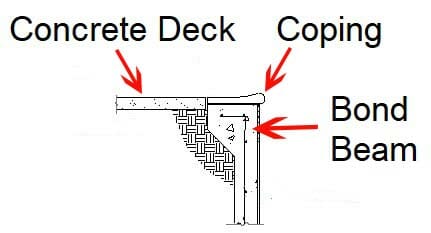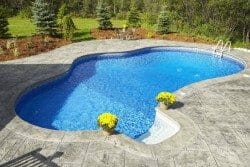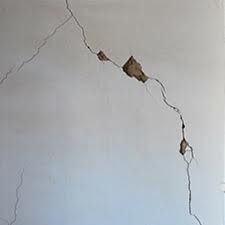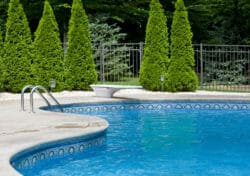Cracked or Missing Tiles in Pools and Spas: When Serious
Home » Pools and Spas »
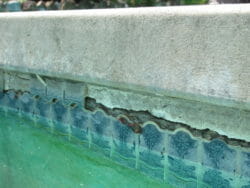
Crack or loose pool or spa tiles may merely be a maintenance item or can be a warning sign of a structural issue.
Over time it is common for a few tiles to become loose or damaged, as well as fade or lose their brilliance. Contractors will often estimate that a concrete gunite or shotcrete inground pool may need re-plastering after 8 to 12 years, depending on the level of maintenance and climatic conditions; they may also suggest that the pool be retiled at the same time.
The waterline area of these pools and spas usually have one or more rows of ceramic tiles. The tile line or band is often about 6 inches wide but may be wider or varied to provide an architectural design look.
Reason for waterline tiles
1. Architectural
Tiles at the waterline provides a variety of architectural highlights to enhance a pools beauty but also provides two other important purposes; ease of cleaning and prevention of water migrating through the pool’s body.
2. Cleaning
Having tile at a pool’s waterline makes it much easier to remove calcium and mineral deposits. Substances like sunscreen oils, body oils, pollen and other floating substances which form a film at the waterline are also easier to remove when there are tiles instead of plaster.
3. Tiles waterproofs the waterline area
Plaster basically makes your pool water proof, for without a plaster coating over the concrete gunite or shotcrete pool shell, water will migrate through the body.
Pool plaster if not covered by water and exposed to the open air will usually develop cracks or flake off over time. Therefore, at the water line areas contractors will usually place rows of tile, rather than have plaster.
Why tiles crack or fall off
Lack of maintenance
Lack of proper maintenance will often be one of the reasons for tiles to become damaged or lose. The lack of proper maintenance includes the pool chemistry, winterizing the pool, proper sealing of pool deck cracks and joints between a concrete deck and the pools’ coping. Failure to provide proper maintenance in any or all of these areas may cause tile problems.
Workmanship

During the construction of a pool, if the tile installers did not install the tile properly or the workmen spraying the gunite or shotcrete over the rebar for the shell added too much water or used a weak mix, then it is likely that there may be tile that will eventually come loose or fall off.
Should there have been too wet of a mix, then laitance may have developed; basically, a weak surface that is not strong enough to hold the tile on. Likewise, if the bonding material used to set the tile was improperly applied or insufficient, then the tile will fall off over time.
Freezing in colder climates

- Water in the joint between the pool deck and its coping. When water builds up and freezes in the joint between a pool’s coping or bond beam and a concrete pool deck, it will expand, up to 9% in volume. This expansion can result in the bond beam cracking, thus the tile over the bond beam may crack or fall off. Likewise, if the coping shifts, it may occasionally result in tile damage.
- Water level over the waterline tile and it freezes. If the water level covers part or all of the waterline tile, it often cracks the tile because of the pressure it exerts on the tile when it expands.
Freezing issues and improper winterization of a pool are one of the more common reasons for tile cracks and damage.
Wrong type of tile used
Tiles for a pool or spa should be manufactured specifically for pool use; they should be engineered to be frost free and not to absorb water. Homeowners and installers may install bathroom tiles, which at times, may not be formulated for pool and spa use.
Bond beam problems
It is not uncommon for tile damage to occur when there are pool bond beam cracks or damage. The majority of bond beam issues arise out of lack of proper separation joints providing room for expansion and contraction between the bond beam, coping and the concrete deck. Cracks in the bond beam area due to the lack of a proper expansion joint are usually horizontal cracks.
Deck movement issues
When there is a concrete deck against a pool and there is soil movement, there is a possibility that it will exert pressure on the bond beam. This is true whether there is separate coping on top of the bond beam or the concrete deck sits on top of the bond beam directly; especially when there are not proper allowances for movement.
Pool cracking / shifting
Pools do not crack easily, however when a pool is built on a hillside lot and there is slope creep or differential settlement, then a pool may crack. If there is cracking it may be evident by cracks in the plaster and tile. These cracks may be at an angle or vertical in nature.
Rebar issues
Should the steel rebar rust in the concrete gunite or shotcrete shell, it will often expand in size and cause cracks in the bond beam which in turn causes tile cracks or the tile to fall off the pool’s body; often to be found on the bottom of the pool.
Structural concerns
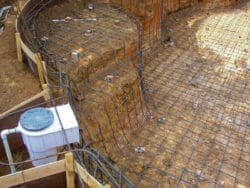
Usually a few cracked or damage tile do not raise much a structural concern in most instances. When there are other signs of pool issues along with cracked and damage tile, then it would be wise to do further investigation. Examples would include:
- Horizontal crack at bond beam area of pool
- Vertical crack through the pool body
- Cracking of tile accompanied by concrete deck issues
- Cracked tile accompanied by excessively wet areas near the pool
- Pool out of level accompanied by cracks in the tile and pools’ body
Further steps and advice
Check the pool for leaks. One method of checking for leaks is to conduct a “Bucket Test.” (Read how to check a pool for leaks)
Check the pool for cracks and levelness. Some of this you can do yourself. (Read how to check a pool for levelness)
Have a pool inspection. Seek out a properly qualified professional pool inspector and have a pool inspection conducted.
Bottom Line
The majority of time, cracked, lose or damaged tiles are a maintenance issue and can be easily corrected, however, occasionally there may be the potential for other problems that have caused the tile issues.
If structural issues are suspected it would be wise to check the pool for levelness and leaks, as well as, seeking professional advice.
